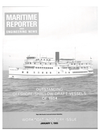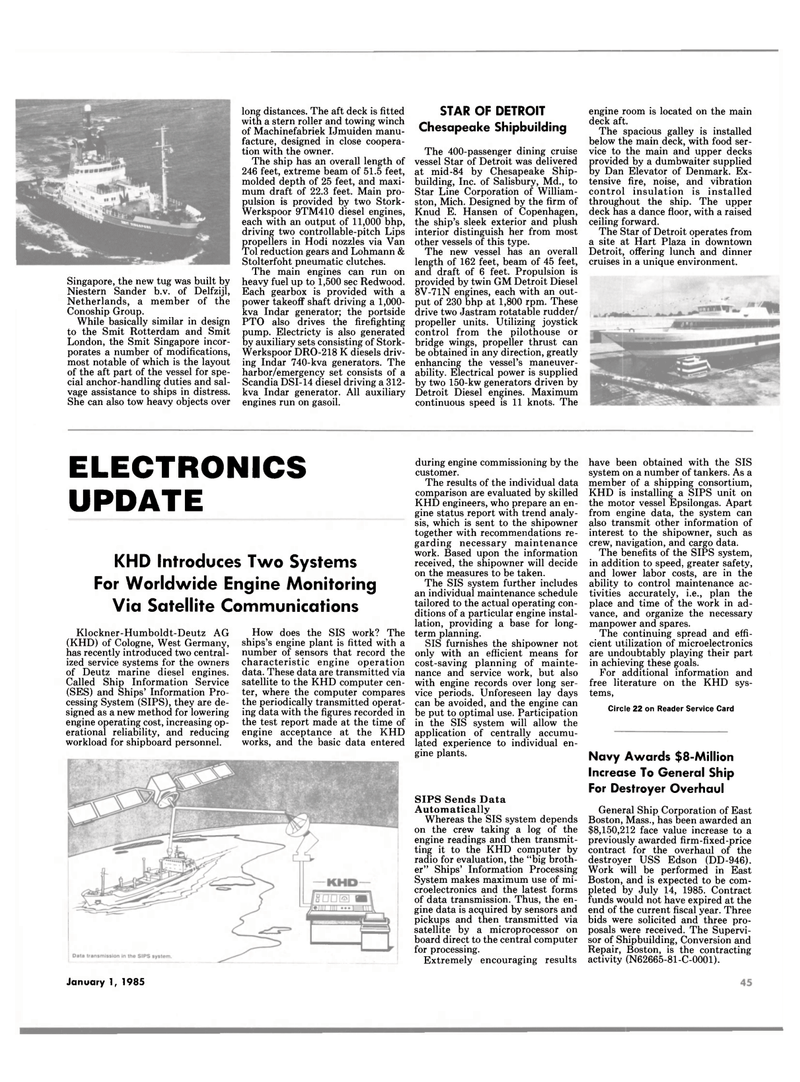
Page 47: of Maritime Reporter Magazine (January 1985)
Read this page in Pdf, Flash or Html5 edition of January 1985 Maritime Reporter Magazine
Singapore, the new tug was built by
Niestern Sander b.v. of Delfzijl,
Netherlands, a member of the
Conoship Group.
While basically similar in design to the Smit Rotterdam and Smit
London, the Smit Singapore incor- porates a number of modifications, most notable of which is the layout of the aft part of the vessel for spe- cial anchor-handling duties and sal- vage assistance to ships in distress.
She can also tow heavy objects over long distances. The aft deck is fitted with a stern roller and towing winch of Machinefabriek IJmuiden manu- facture, designed in close coopera- tion with the owner.
The ship has an overall length of 246 feet, extreme beam of 51.5 feet, molded depth of 25 feet, and maxi- mum draft of 22.3 feet. Main pro- pulsion is provided by two Stork-
Werkspoor 9TM410 diesel engines, each with an output of 11,000 bhp, driving two controllable-pitch Lips propellers in Hodi nozzles via Van
Tol reduction gears and Lohmann &
Stolterfoht pneumatic clutches.
The main engines can run on heavy fuel up to 1,500 sec Redwood.
Each gearbox is provided with a power takeoff shaft driving a 1,000- kva Indar generator; the portside
PTO also drives the firefighting pump. Electricty is also generated by auxiliary sets consisting of Stork-
Werkspoor DRO-218 K diesels driv- ing Indar 740-kva generators. The harbor/emergency set consists of a
Scandia DSI-14 diesel driving a 312- kva Indar generator. All auxiliary engines run on gasoil.
STAR OF DETROIT
Chesapeake Shipbuilding
The 400-passenger dining cruise vessel Star of Detroit was delivered at mid-84 by Chesapeake Ship- building, Inc. of Salisbury, Md., to
Star Line Corporation of William- ston, Mich. Designed by the firm of
Knud E. Hansen of Copenhagen, the ship's sleek exterior and plush interior distinguish her from most other vessels of this type.
The new vessel has an overall length of 162 feet, beam of 45 feet, and draft of 6 feet. Propulsion is provided by twin GM Detroit Diesel 8V-71N engines, each with an out- put of 230 bhp at 1,800 rpm. These drive two Jastram rotatable rudder/ propeller units. Utilizing joystick control from the pilothouse or bridge wings, propeller thrust can be obtained in any direction, greatly enhancing the vessel's maneuver- ability. Electrical power is supplied by two 150-kw generators driven by
Detroit Diesel engines. Maximum continuous speed is 11 knots. The engine room is located on the main deck aft.
The spacious galley is installed below the main deck, with food ser- vice to the main and upper decks provided by a dumbwaiter supplied by Dan Elevator of Denmark. Ex- tensive fire, noise, and vibration control insulation is installed throughout the ship. The upper deck has a dance floor, with a raised ceiling forward.
The Star of Detroit operates from a site at Hart Plaza in downtown
Detroit, offering lunch and dinner cruises in a unique environment.
ELECTRONICS
UPDATE
KHD Introduces Two Systems
For Worldwide Engine Monitoring
Via Satellite Communications
Klockner-Humboldt-Deutz AG (KHD) of Cologne, West Germany, has recently introduced two central- ized service systems for the owners of Deutz marine diesel engines.
Called Ship Information Service (SES) and Ships' Information Pro- cessing System (SIPS), they are de- signed as a new method for lowering engine operating cost, increasing op- erational reliability, and reducing workload for shipboard personnel.
How does the SIS work? The ships's engine plant is fitted with a number of sensors that record the characteristic engine operation data. These data are transmitted via satellite to the KHD computer cen- ter, where the computer compares the periodically transmitted operat- ing data with the figures recorded in the test report made at the time of engine acceptance at the KHD works, and the basic data entered during engine commissioning by the customer.
The results of the individual data comparison are evaluated by skilled
KHD engineers, who prepare an en- gine status report with trend analy- sis, which is sent to the shipowner together with recommendations re- garding necessary maintenance work. Based upon the information received, the shipowner will decide on the measures to be taken.
The SIS system further includes an individual maintenance schedule tailored to the actual operating con- ditions of a particular engine instal- lation, providing a base for long- term planning.
SIS furnishes the shipowner not only with an efficient means for cost-saving planning of mainte- nance and service work, but also with engine records over long ser- vice periods. Unforeseen lay days can be avoided, and the engine can be put to optimal use. Participation in the SIS system will allow the application of centrally accumu- lated experience to individual en- gine plants.
SIPS Sends Data
Automatically
Whereas the SIS system depends on the crew taking a log of the engine readings and then transmit- ting it to the KHD computer by radio for evaluation, the "big broth- er" Ships' Information Processing
System makes maximum use of mi- croelectronics and the latest forms of data transmission. Thus, the en- gine data is acquired by sensors and pickups and then transmitted via satellite by a microprocessor on board direct to the central computer for processing.
Extremely encouraging results have been obtained with the SIS system on a number of tankers. As a member of a shipping consortium,
KHD is installing a SIPS unit on the motor vessel Epsilongas. Apart from engine data, the system can also transmit other information of interest to the shipowner, such as crew, navigation, and cargo data.
The benefits of the SIPS system, in addition to speed, greater safety, and lower labor costs, are in the ability to control maintenance ac- tivities accurately, i.e., plan the place and time of the work in ad- vance, and organize the necessary manpower and spares.
The continuing spread and effi- cient utilization of microelectronics are undoubtably playing their part in achieving these goals.
For additional information and free literature on the KHD sys- tems,
Circle 22 on Reader Service Card
Navy Awards $8-Million
Increase To General Ship
For Destroyer Overhaul
General Ship Corporation of East
Boston, Mass., has been awarded an $8,150,212 face value increase to a previously awarded firm-fixed-price contract for the overhaul of the destroyer USS Edson (DD-946).
Work will be performed in East
Boston, and is expected to be com- pleted by July 14, 1985. Contract funds would not have expired at the end of the current fiscal year. Three bids were solicited and three pro- posals were received. The Supervi- sor of Shipbuilding, Conversion and
Repair, Boston, is the contracting activity (N62665-81-C-0001).
January 1, 1985 23

 46
46

 48
48
